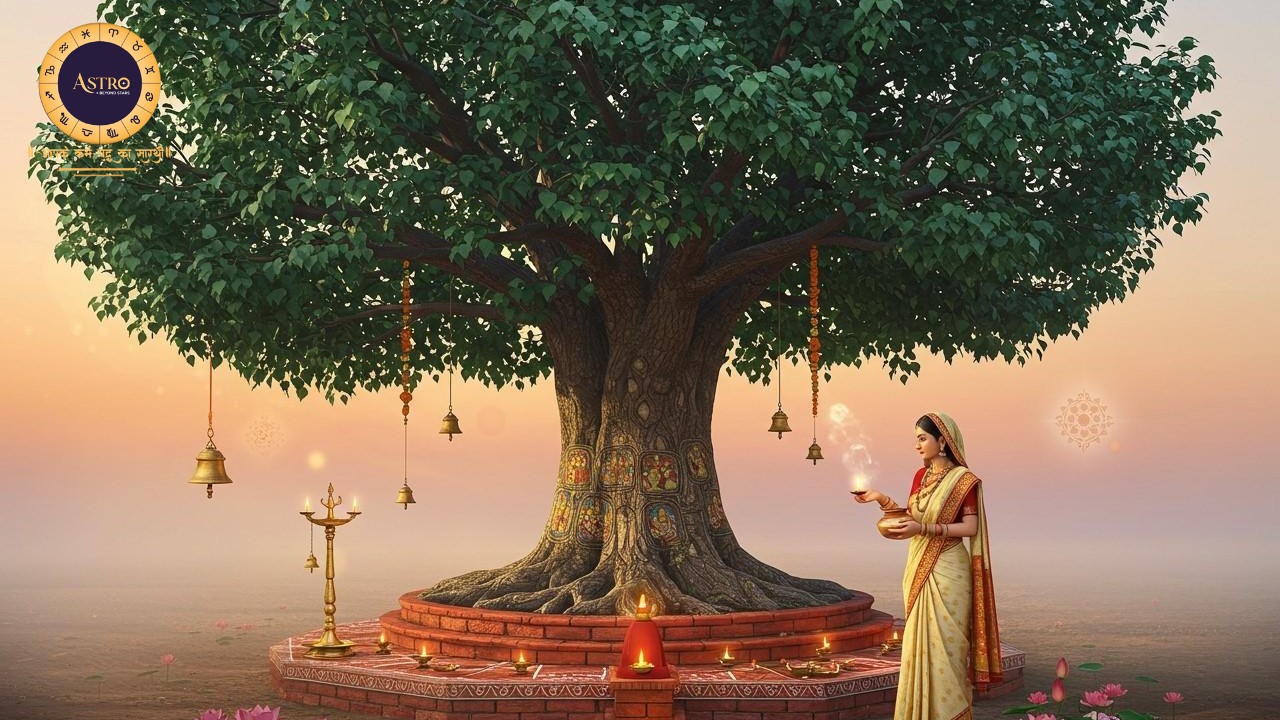The Peepal tree (Ficus religiosa) is of profound importance in Indian culture, religion, and mythology, enveloped in a myriad of beliefs and enigmas. While it is venerated as a sacred entity, it is also linked to supernatural narratives, including the notion that it serves as a dwelling for spirits or ghosts.
Below is an exploration of the religious and mystical connections associated with the Peepal tree:
Religious Significance and Sacredness Dwelling of Lord Vishnu:
As per the Skanda Purana, Lord Vishnu is said to inhabit the Peepal tree, which elevates its status of reverence. It is regarded as a holy tree, frequently worshipped on Saturdays and during particular rituals.
Representation of the Hindu Trinity:
The tree is occasionally viewed as a symbol of the Hindu Trinity: Brahma (roots), Vishnu (trunk), and Shiva (branches and leaves). Akshay Vriksha (Eternal Tree): The Peepal tree is referred to as the “Akshay Vriksha” due to its evergreen nature and the perpetual fluttering of its leaves, which signify continuity and vitality.
Mysterious and Supernatural Connections Dwelling of Spirits and Ghosts: In folklore, the Peepal tree is perceived as a habitat for spirits and ghosts, especially at night. This belief may arise from the unsettling atmosphere created by the rustling of its heart-shaped leaves in the dark. It is thought that preta-atmas (restless souls) or malevolent spirits are present around this tree during night time, leading to advisories against sitting or sleeping beneath it after sunset.
Peepal Tree in the Bhagavad Gita (Chapter 10, Verse 26), Lord Krishna proclaims: “Ashvatthah Sarvavrikshanam” (Among all trees, I am the Peepal.) By associating himself with the Peepal tree, Lord Krishna emphasizes its sacred significance, representing eternal life, wisdom, and universal energy.
As a representation of Lord Vishnu, the Peepal tree is regarded as a living embodiment of Lord Vishnu and his various forms:
1.Roots: Symbolize Vishnu, the sustainer of life and the cosmos.
2.Trunk: Represents Keshav, a manifestation of Vishnu that embodies divine strength.
3.Branches: Reflect Narayana, signifying divine omnipresence.
4.Leaves: Denote Shree Hari, the essence of vitality and life force.
5.Fruits: Represent Achyuta, the eternal and imperishable aspect of Vishnu.
This association elevates the Peepal tree to a divine status, deserving of veneration and respect.
Sacred Practices and Beliefs Worship and Atonement:
In ancient times, sages and saints engaged in meditation and penance beneath the Peepal tree, believing it to be charged with divine energy. It remains a prevalent practice to circumambulate the Peepal tree, particularly on Saturdays and during auspicious times, to seek blessings and the fulfilment of wishes.
Cleansing of Sins:
Pouring water on the Peepal tree is thought to cleanse an individual of sins accumulated over past lifetimes. This act is viewed as a means of repentance and spiritual purification.
Connection to Ancestors:
The tree is frequently honored during Pitru Paksha, and amawasya (the no moon day), a time dedicated to commemorating ancestors, as it is believed to bridge the earthly realm with the spiritual domain.
Symbol of Eternal Life Referred to as “Akshay Vriksha,” or the imperishable tree, the Peepal signifies:
Immortality: Its evergreen nature and capacity to thrive in adverse conditions symbolize resilience and everlasting life.
Continuity: Its perpetual growth and regeneration mirror the endless cycle of creation and destruction, akin to the rhythms of the universe.
Spiritual Benefits
The Peepal tree is regarded as a source of positive energy.
Nocturnal Presence:
The scientific rationale behind this belief relates to the tree’s process of oxygen and carbon dioxide exchange. While the Peepal tree emits oxygen during the day through photosynthesis, it releases carbon dioxide at night, and also opens up its stomata, which could lead to discomfort for anyone resting underneath it. This phenomenon may have contributed to its supernatural associations.
Peepal as a Site for Meditation and Worship:
Ascetics and yogis frequently choose to meditate under the Peepal tree due to its tranquil and peaceful surroundings. However, this practice has also given rise to tales of ghosts. Encounters, as these experiences are often recounted by those who seek solace beneath its branches.
The Peepal tree, while revered as sacred and associated with Lord Vishnu, also has a complex set of beliefs tied to ancestors, spirits, and even the goddess Alakshmi. These beliefs combine spiritual, cultural, and superstitious elements, creating a fascinating duality around the tree.
Peepal Tree as the Abode of Ancestors and Spirits
Connection to Ancestors (Pitru):
The Peepal tree is believed to be a dwelling place for ancestral spirits (Pitru). Offering water, lighting a lamp, or performing rituals under the tree is thought to appease these spirits and help resolve Pitra Dosh (ancestral curses or unresolved debts).
Ghosts and Spirits at Night:
A common belief is that ghosts and wandering spirits reside in or around the Peepal tree, especially during the night.
This may have originated from its eerie ambiance at night—the rustling of leaves and the dense canopy of the leaves, that can create an unsettling environment.
In villages, bones from cremation ceremonies are sometimes tied to the tree, reinforcing the association with the dead. This practice likely stemmed from the belief that the tree connects the physical and spiritual realms.
Avoiding the Tree at Night:
People are often advised not to go near the Peepal tree after sunset or look back after lighting a lamp under it. This is believed to prevent potential disturbances from spirits or negative energies lingering near the tree.
Belief in Alakshmi’s Presence
Who is Alakshmi?
Alakshmi, also known as Daridra Devi, is the elder sister of Goddess Lakshmi. She represents misfortune, poverty, and discord, contrasting with Lakshmi’s prosperity and abundance.
According to beliefs, Alakshmi resides under the Peepal tree. However, this duality is not entirely negative—her presence can be balanced through the blessings of Lord Vishnu and Goddess Lakshmi.
Worship for Prosperity:
Devotees worship the Peepal tree on Saturdays to counteract Alakshmi’s influence and invoke the blessings of Vishnu and Lakshmi.
Engaging in rituals beneath the Peepal tree is thought to attract wealth, promote harmony, and yield favorable outcomes, transforming its spiritual essence into a beneficial influence.
The act of cutting down a Peepal tree is regarded as extremely inauspicious, as it is believed to invoke Pitra Dosh. This belief may stem from the notion that the tree serves as a sacred dwelling for both deities and ancestors. Symbolically, damaging the Peepal tree disturbs the spiritual bond with one’s forebears and the divine.
From a scientific and cultural perspective, it is noted that the Peepal tree, like other trees, emits carbon dioxide at night, which can lead to discomfort for individuals who sit or rest beneath it. This phenomenon may have contributed to the superstition surrounding spirits associated with the tree.
Rituals such as lighting lamps or offering prayers under the Peepal tree carry profound symbolism and promote mental tranquility. These acts of devotion may also cultivate a sense of gratitude and connection to one’s ancestors and the divine.
The dual nature of the Peepal tree, associated with both divine blessings and spirits, embodies the Hindu belief in balance—the coexistence of both auspicious and inauspicious forces within nature. While it is perceived as a sanctuary for ancestors and even Alakshmi, its veneration is believed to harmonize these energies, fostering prosperity, peace, and spiritual development.




